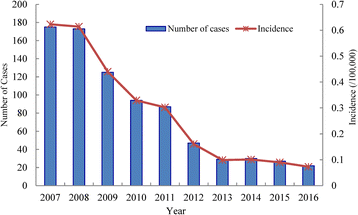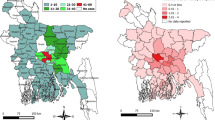Abstract
To analyze features of the rabies epidemic in China between 2007 and 2011, identify factors influencing the epidemic and to provide a scientific basis for further control and prevention of rabies, Descriptive epidemiological methods and statistical analysis was used on data collected from the National Disease Reporting Information System between 2007 to 2011 and the National Active Surveillance System between 2007 and 2010. Our analysis shows that while the number of human rabies cases decreased year by year, the number of districts reporting cases did not show significant change. The situations in Guangdong, Guangxi, Guizhou and Hunan provinces clearly improved over the period but they remain provinces with high-incidence, and consequently influence the epidemic situation of surrounding provinces and possibly the whole country. Summer and autumn were high-incidence seasons. Farmers, students and pre-school children represent the high-risk populations, and rates of cases in farmers increased, those for students decreased, and pre-school children remained unchanged. Provinces with active surveillance programs reported a total of 2346 individual cases, of which 88.53% were associated with canines. Postexposure prophylaxis (PEP) of rabies cases was not significantly improved, whereas PEP in post-exposure population was good. In rural regions of China, canine density was reduced somewhat, and the immunization rate increased slightly. Finally we show that while the epidemic decreased 2007 to 2011 in China, cases continued to be diffused in certain regions. Lack of standardization of PEP on rabies cases was the main reason of morbidity. The high density and low immunization of dog in rural areas and the defective situation of PEP are still continuous occurrences in China and remain a cause for concern.
Similar content being viewed by others
References
Dong G M, Xu G L, Xiao Q Y, et al. 2007. An Epidemiological Study of Rabies Virus in Domestic Dogs, Cats and Wildlife And the Immunogenicity Study for Rabies Vaccines Derived from Different Cell Cultured Virus Strains. Chin J Virol, 23(6): 417–423. (in Chinese)
Hu R L, Fooks A R, Zhang S F, et al. 2008. Inferior rrabies vaccine quality and low immunization coverage in dogs (Canis familiaris) in China, Epidemiol Infect, 136(11): 1556–1563.
Liang Y M. 2010. Observation of the effects of inoculation with a domestic lyophilized non-adjuvanted rabies vaccine derived from Vero cells. J Path Biol, 5(6): 421–424.
Meng S L, Xu G L, Cheng M R, et al. 2010. Analysis of Genetic Diversity of Rabies Virus Isolates in China. Chin J Biologicals, 23(5): 449–454. (in Chinese)
Ministry of Health. 2005. Plan for national rabies surveillance (Draft). Ministry of Health, Beijing (in Chinese)
National Pharmacopoeia Committee, 2010. The Third of Pharmacopoeia of the Peoples Republic of China, Beijing: Chinese medicine science and Technology Press, 107–118. (in Chinese)
Song M, Tang Q, Wang D M, et al. 2009. Epidemiological investigations of human rabies in China. BMC Infect Dis, 9: 210.
Tang Q, Li H. 2005. Epidemic situation and related factors analyses of rabies in China. Chin J Epidemiol, 26(3): 223–224. (in Chinese)
Tang Q, Wang, X J, Yu G K, et al. 2008. WS281-2008 Rabies Diagnosis Criteria. Ratified by ministry of Heath. Beijing: People’s Sanitation Publishing Co. (in Chinese)
US CDC. 2004. Reports first recorded transmission of rabies form organ transplants. Health &Medicine Week, 10–17.
Wang Y Z, Zhang S F, Hu R L, et al. 2005. Construction and immunogenicity of recombinant Canine adenovirus type 2 with the external part of glycoprotein of Rabies virus, Acta Microbiol Sin, 45(20):213–217. (in Chinese)
WHO. 2010. Weekly epidemiological record, Geneva, World Health organization, 85(32): 309–320.
WHO Expert Consultation Rabies 2005. First Report WHO technical report series. Geneva World Health Organization 9311–88
Xiong C L, Shao Z J, Jiang Q W, et al. 2010. Analyses on N gene sequence of 9 rabies virus isolates in Henan province, China. Fudan Univ J Med Sci, 37(3): 331–335. (in Chinese)
Xu Z R. 2009. Adverse Reaction of Rabies Vaccine for Human Use Prepared with Vero Cells. Chin J Biologicals, 22(4):385–386. (in Chinese)
Yi B, Fang T, Zhou A M. 2009. Analysis of rabies epidemic factors from 2004 to 2008 in Ningbo city. Chin J Vector Bio Control, 20(6): 577–579. (in Chinese)
Yuan H J, Hu R L, Zhang S F, et al. 2004. Immunological experiment on dogs by Rabies virus glycoprotein/ nucleoprotein DNA vaccine and IL218, Chin J Zoonoses, 20(12): 1075–1078. (in Chinese)
Zhang F, Zhang S F, Liu Y, et al. 2011. Continual surveillance on rabies immunization coverage in dog population in some regions of China, Chin J Vet Parasitol, 19(1): 68–71. (in Chinese)
Zhang H L, Tang Q, Tao X Y, et al. 2008. Survey on human rabies cases and its viral molecular biological features in Baoshan city, Yunnan province. Chin J Epidemiol, 29(9): 899–894.
Zhang Y Z, Xiao D L, Sun Y H, et al. 2003. The epidemic situation of human rabies from 1984 to 2002 and its preventive measures in China. Chin J Epidemiol, 24(10):883–886. (in Chinese)
Zhang Y Z, Xiong C L, Zou Y, et al. 2006. An epidemiological study on rabies in Wugang and Dongkou counties, Hunan. Chin J Epidemiol, 27(7): 583–588. (in Chinese)
Zhou K J, Mo Z J, Chen M M, et al. 2011.Survey and analysis of infection rate of rabies virus among healthy dogs in Guangxi, 2006–2007. Applied Prev Med, 17(1):17–20.
Zou L B, Guo J G, Zheng L F, et al. 2010. Epidemiological investigation and integrated management of rabies in Guangxi province. Chin J Zoonoses, 26(2): 193–194. (in Chinese)
Author information
Authors and Affiliations
Corresponding author
Additional information
Foundation items: National Department Public Benefit Research Foundation (201103032); and the Pathogens Network Monitoring Technology Research (2008ZX10004-008)
Rights and permissions
About this article
Cite this article
Yin, Cp., Zhou, H., Wu, H. et al. Analysis on factors related to rabies epidemic in China from 2007–2011. Virol. Sin. 27, 132–143 (2012). https://doi.org/10.1007/s12250-012-3244-y
Received:
Accepted:
Published:
Issue Date:
DOI: https://doi.org/10.1007/s12250-012-3244-y




